The Qavam al- Saltaneh House, also known as the Qavam Garden, is an exquisite historical mansion located in Tehran, Iran. Situated in the heart of 30 Tir Street, just a few steps away from Jomhouri Street, amidst the bustling throngs of both Iranian and foreign tourists, stands the Qavam al-Saltaneh House. This historic gem, nestled within a Qajar-era garden, hosts a distinctive architectural style, characterized by wooden lattice windows and a pristine garden. Once the residence and office of Ahmad Qavam, known as the Churchill of Iran, the progressive Prime Minister of Iran for three decades, today it serves as an exhibition that narrates the story of pottery and glass craftsmanship in Iran. Keep reading our blog post in Parsi Tours Iran Travel Agency to delve deeper into the intriguing history and stunning beauties of The Qavam al-Saltaneh House
A jewel of Qajar Era Heritage
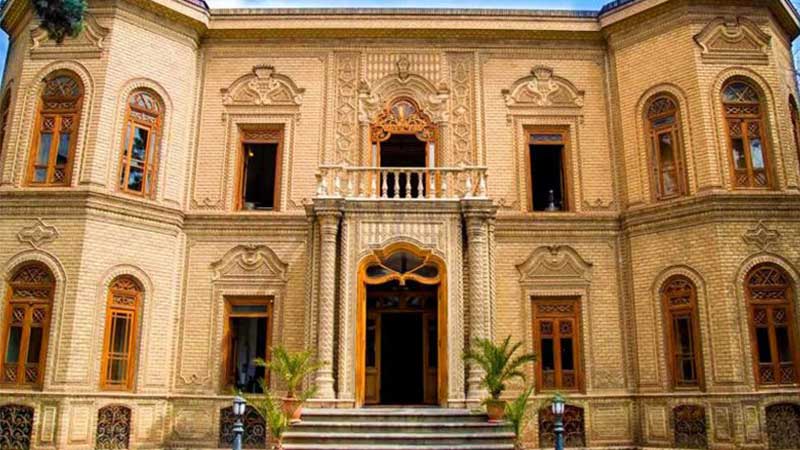
The house was constructed during the Qajar era, which spanned from the late 18th century to the early 20th century. This period was characterized by a flourishing of Persian arts and culture, and the Qavam al-Sultaneh House stands as evidence to the architectural and artistic achievements of the time.
Garden Setting of Qavam al-Saltaneh House
The mansion is set within a beautiful garden that adds to its charm. The well-maintained garden features lush greenery, fountains, and pathways, creating a serene and picturesque environment that contrasts with the bustling streets of Tehran outside its gates.
Architectural Details of Qavam House
Beyond the wooden lattice windows and unique brickwork mentioned in the previous section, the Qavam al-Saltaneh House boasts intricate details throughout. Elaborate stucco work, ornate tile work, and finely carved woodwork can be found throughout the interior, showcasing the skill of the craftsmen of the time.
Historical Significance of Qavam al-Saltaneh House
The house is not only a reflection of the architectural style of the Qajar period but also holds historical significance as the residence of Ahmad Qavam, a prominent political figure. It provides a glimpse into the life of a key statesman who played a role in shaping Iran’s political landscape during a critical period in its history.
Cultural Events in Qavam al-Saltaneh House
In addition to being a museum, the Qavam al-Saltaneh House occasionally hosts cultural events and exhibitions. These events can range from art exhibitions to traditional music performances, offering visitors a chance to engage with Iran’s vibrant cultural scene.
Restoration Efforts During Time

Over the years, there have been efforts to restore and preserve the Qavam al-Saltaneh House. These efforts aim to maintain its historical integrity and ensure that future generations can continue to appreciate its architectural and cultural significance.
Biography of Qavam al-Saltaneh (Ahmad Qavam)
Ahmad Qavam, affectionately known as Qavam al-Saltaneh, was a highly influential Iranian statesman who held the position of Prime Minister thrice during the Qajar era and twice during the Pahlavi era. He served as Minister of Internal Affairs on 14 occasions, Minister of Foreign Affairs four times, Minister of Finance four times, Minister of War twice, and Minister of Justice once. During the late Qajar period, while he was Prime Minister under Ahmad Shah, he commissioned the construction of the magnificent residence, which has now become one of Tehran’s most significant historical landmarks. The architecture of this house is renowned, and no visitor to Tehran can afford to miss the Qavam al-Saltaneh House.
Qavam al-Saltaneh House is among the most prominent historical houses in Tehran today, distinguished by its unique and captivating architecture.
Qavam al-Saltaneh House Attractions
Before being transformed into a museum of pottery and glass, Qavam al-Saltaneh House beckons visitors along 30 Tir Street, guiding them toward the rich history of the glass and pottery industry. This historical house captivates every visitor with its remarkable architecture, and the building itself is as awe-inspiring as the museum’s exhibits.
The Qavam House is a two-story building set within a 7,000-square-meter garden with an octagonal layout, featuring 50 varieties of brickwork on its exterior facade. Its distinctive wooden doors and windows are adorned with symbols reminiscent of Seljuk-era Iranian architecture.
The Architecture of Qavam al-Saltaneh House
While this house melds Iranian and European architectural elements, with its Russian-style staircase, the craftsmanship of Iranian artisans is evident throughout. Elaborate carvings embellish doors and staircases, while plastered ceilings and columns, along with strategically placed mirrors, infuse the house with a distinctly Iranian ambiance. Following the 1979 revolution, additional mirror work was added on the second floor, featuring religious and revolutionary themes.
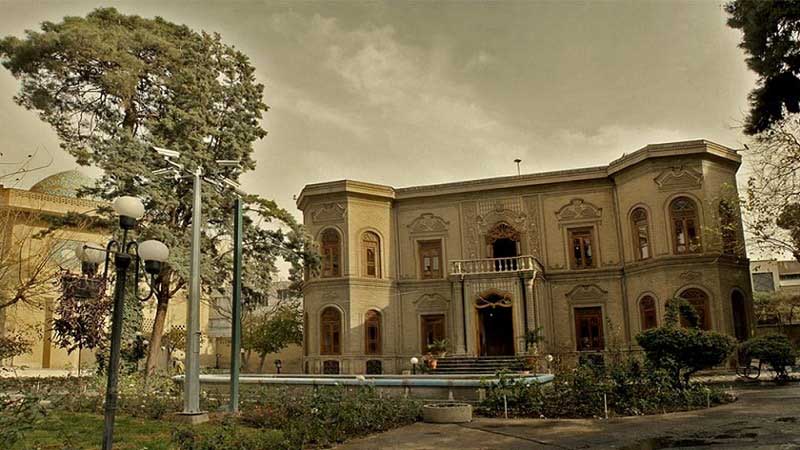
The Architecture of Qavam al-Saltaneh House
The creaking stairs and wooden floors of Qavam al-Saltaneh House, bearing geometric designs in square, triangle, and circle shapes, have whispered their stories for generations. Every step you take echoes with the unchanged history of the building. The structure remains mostly intact, with only minor alterations and limited intrusions.
Exploring the History of Qavam al-Saltaneh House
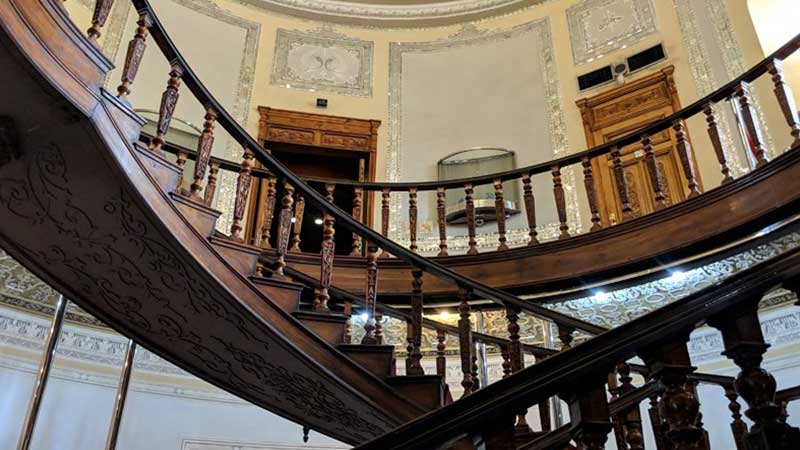
From 1300 to 1330, this historic house served as the residence of Qavam al-Saltaneh, also known as Hazrat Ashraf. Subsequently, it housed the Egyptian embassy, which introduced European-style stucco to some of the first-floor halls. An observant eye can spot the flag of the Egyptian embassy discreetly incorporated into the stucco. Afterward, the Afghan embassy briefly took ownership before the property passed to a commercial bank. Ultimately, Farah Pahlavi’s office acquired this Qajar mansion in 1355, transforming it into a museum. The museum’s design was entrusted to Iranian engineers, with the interior architecture and showcases designed by Hans Hollein, a prominent Austrian architect. Hollein drew inspiration from Iran’s iconic historical works, such as Tachara’s Palace, the columns of Persepolis, Safavid arches, and the Zoroastrian Kaaba. While the museum’s showcases and overall atmosphere are modern in design, the traditional essence of the building remains unaltered and in perfect harmony.
Abgineh Museum
The design of the Abgineh Museum, considered one of Hollein’s finest works, cleverly employs empty spaces in its interior layout, ensuring that visitors feel invigorated rather than fatigued during their exploration. This design approach is less evident in Hollein’s later projects, which tend to feature more crowded halls.
The design of the Abgineh Museum is widely regarded as one of Hollein’s masterpieces.
Abgineh Museum attractions
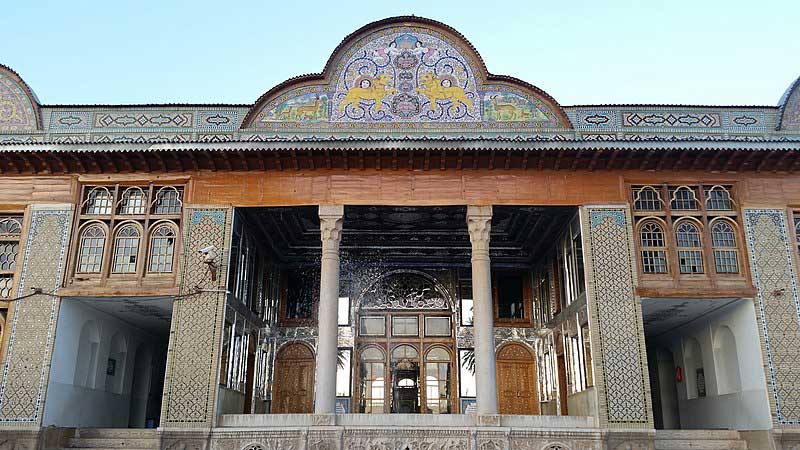
The interior design of the Abgineh Museum is marked by its exceptional showcases and innovative concepts. These showcases, inspired at times by the columns of Persepolis, Dariush Achaemenid’s Tachara’s Palace, and Zoroaster’s Kaaba in Naghsh-e Rostam, are truly unique. Qavam al-Saltaneh House, or rather the Abgineh Museum, spans two floors and encompasses five halls. The first-floor halls exhibit glass and pottery artifacts from the pre-Islamic era, while the second-floor halls showcase works from the Islamic era.
Various Sections of the Abgineh Museum
In addition to its exhibition spaces, the Abgineh Museum encompasses administrative facilities in the basement, including a secretariat and the chief’s office located on the upper floor. The museum’s library, situated in the northwest corner, houses an impressive collection of 4,000 volumes of Persian and English books covering the fields of archaeology, history, and art.
A Distinctive Feature of Abgineh Museum’s Interior Design
One of the most prominent aspects of the Abgineh Museum’s interior design is the unique configuration of its showcases and the innovative concepts implemented by Hollein in this regard. The arrangement of these showcases is particularly noteworthy.
Abgineh Museum’s Popularity Among Tourists
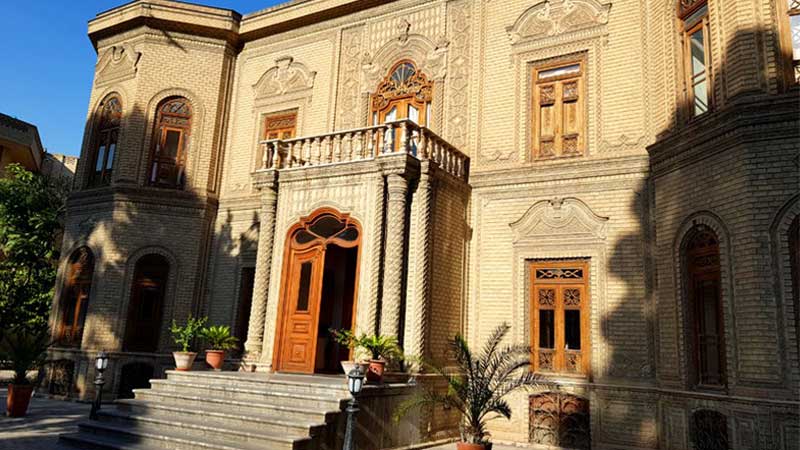
The Abgineh Museum ranks as one of Tehran’s most frequented cultural institutions, with a significant portion of its visitors being international tourists. On average, the museum receives over 2 million visitors annually. Unfortunately, in 1379, thieves targeted the museum and pilfered historical artifacts, some of which remain unaccounted for to this day. The investigation into this collection’s theft remains an open case within the legal system.
Conclusion
Overall, the Qavam al-Saltaneh House is an enchanting destination for history enthusiasts, architecture admirers, and anyone interested in exploring Iran’s rich cultural heritage. Its combination of architectural beauty, historical importance, and serene garden setting makes it a must-visit attraction in Tehran.



